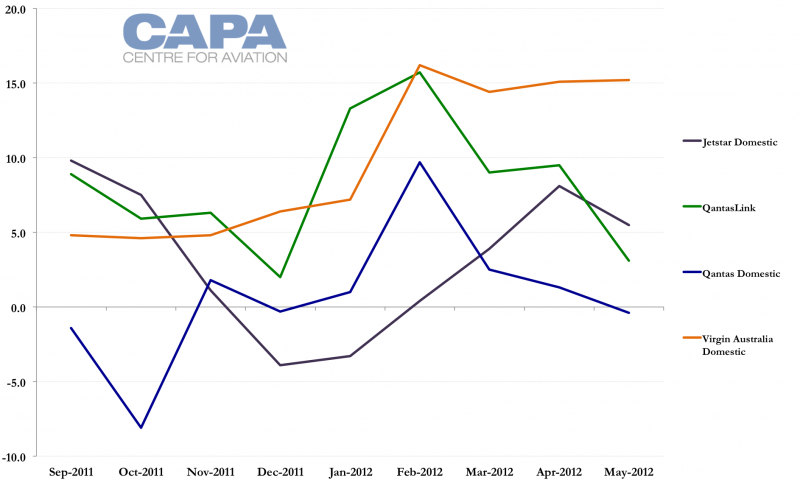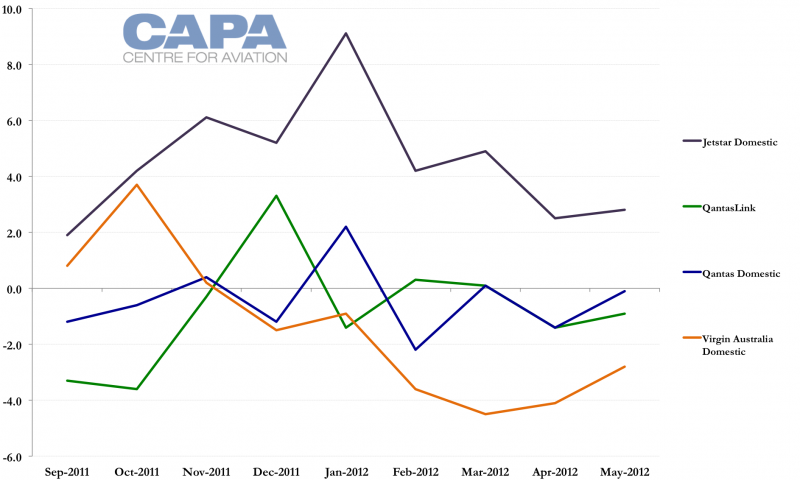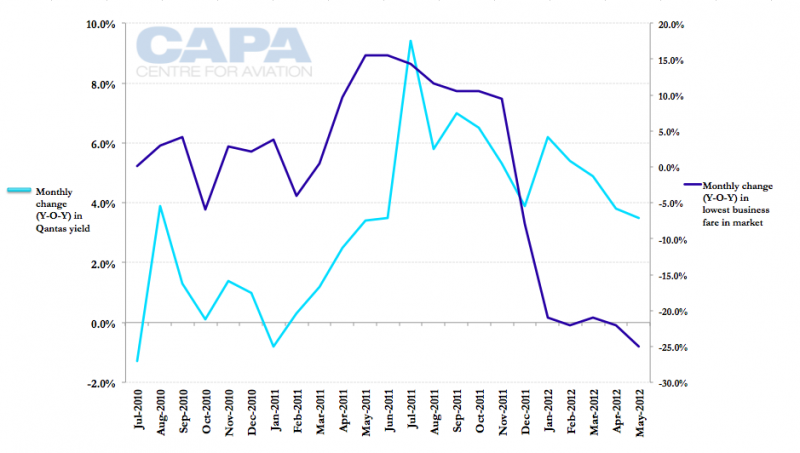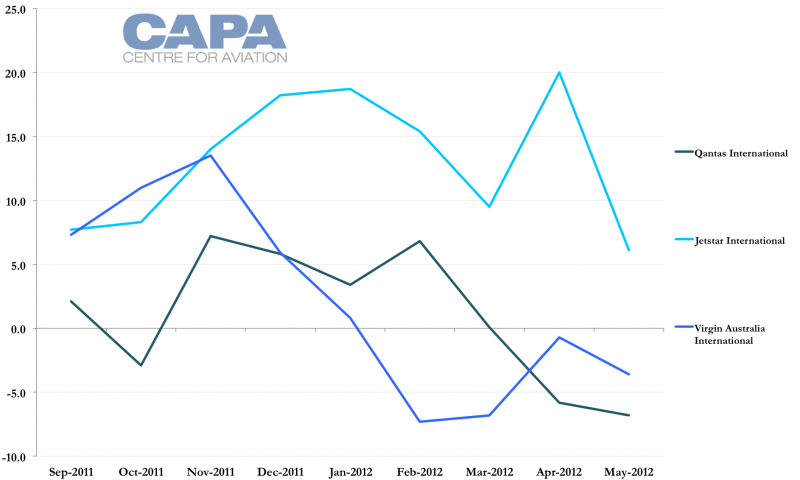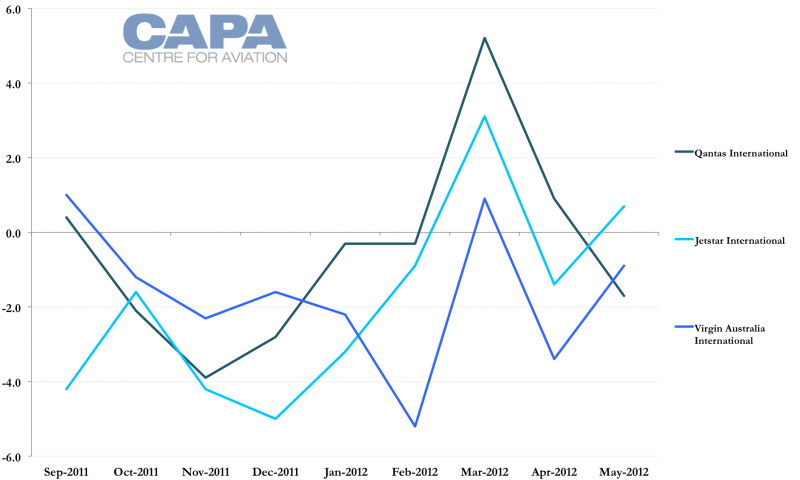Virgin Australia's bullish medium-term expansion challenges Qantas, as Gulf carriers circle
Virgin Australia's fleet update, including an order for 23 Boeing 737 MAX 8s, shows that it remains bullish on medium-term growth prospects that will continue to challenge Qantas' historically strong position in the domestic Australian market, its foundation for profitability, as sixth freedom carrier expansion has decreased its international network.
Qantas has reported slowing yield growth in each of the four months since Virgin Australia launched business class across its network in Jan-2012, a trend CEO Alan Joyce expects to continue.
Virgin's early success in increasing corporate traffic, and no slowing of growth, means the carrier will soon need new strategic goals that will undoubtedly include a further slice of the lucrative corporate market. Further growth at Virgin will challenge Qantas' 65% market share and yield profile.
Meanwhile, a combination with either or both of Emirates and Qatar Airways may be what Qantas needs to jolt it out of the current despond.
Virgin Australia has potential for higher medium-term growth
Virgin on 05-Jul-2012 announced an order for 23 737 MAX 8 aircraft (with four options) for delivery in quick succession between 2019 and 2021. These will mostly be for replacement, but more insightful was the carrier's first disclosure in recent times of medium-term fleet and growth plans. Over the past few reporting periods Virgin has maintained its furthest projection of 71 737s by the end of Jun-2013, up from 62 at the end of Jun-2010, a net addition of nine after 33 deliveries and 24 lease returns.
Between 2013 and 2016, Virgin intends to take 31 737-800s, some of which will be used for growth and some for replacement. In that period Virgin will have, according to aircraft registries, approximately 25 737s that will be older than eight years, exceeding a guideline used by Virgin (and some LCCs) not to operate aircraft older than that age due to higher maintenance costs. But Virgin has flexibility with leases and could easily keep some of its older 737s, especially as it would mean a few years' wait would enable replacement with a far more efficient 737 MAX than 737 NG.
Virgin could potentially have a 15% (or higher) increase in 737 fleet size from 2013 to 2016, as it has from 2010 to 2013, although seat growth in 2013-2016 would be slightly lower as the carrier in the current period has been replacing smaller 737-700s with larger 737-800s. (All 737-700s are due to leave its fleet by the end of 2013.) But whereas the 737 has formed the anchor role in Virgin Australia's fleet, the carrier now also has A330s and ATR 72s operating domestically.
Both of those types have been increased steadily in number. Virgin started with two A330s in late FY2011 and, at its most recent disclosure, intends to have six by the end of FY2013. CEO John Borghetti has routinely hinted at further A330 growth, a key part of a domestic product strategy.
In Feb-2012 Virgin also disclosed it would not return two ATR 72s due for delivery, thus boosting its ATR 72 fleet from eight to 12 by FY2013. The ATR 72s are used on routes to regional Australia, a market that holds large potential and could easily support higher growth as it delivers competition to QantasLink, which Mr Joyce has termed the "quiet achiever" (and consistently the most profitable airline in the Group over the years).
Virgin in early 2010 had planned for higher 737 growth, intending to take all 55 from an Apr-2010 order, and 14 from a previous order, by the end of 2017, according to statements at the time. The carrier now intends to take approximately 60 737s by the end of 2016, leaving approximately nine for after 2016. Virgin says it has delayed an unspecified number until after 2016 (which would likely be converted to MAXs, although Boeing has been hesitant to support such a policy).
Assuming Virgin is delaying the nine outstanding frames, that loss of growth will be offset with additional A330s and ATR72s - and still represents higher growth between 2013 and 2016 than in the three prior years.
More widebody aircraft as Mr Borghetti cautiously expands
Virgin says the deferral of some 737s "gives the airline flexibility to develop the appropriate mix of narrow-body and wide-body aircraft", implying the long-expected increase in widebody aircraft will occur. Additional A330s are definitely on the cards for the both the short- and medium-future term.
Flexibility is certainly a key word in uncertain times (uncertain both in terms of threats and opportunities). The A330s can be deployed on domestic trunk routes but also internationally, either to Asia in the medium-term if the market will support the move, or used to provide one-stop ultra long-haul service. Qantas had an A330 service from Australia to Los Angeles via Auckland while Virgin's partner Etihad operates from Brisbane to Abu Dhabi via Singapore. Both of those routes could be contenders, and indeed Virgin already flagged a Brisbane-Singapore-Abu Dhabi service but indefinitely postponed it in order instead to support domestic growth.
Capacity freed up from 777s could allow those aircraft to be redeployed on more key non-stop long-haul markets, or potentially re-enter Johannesburg - depending on the outcome of Qantas' codeshare agreement with South African Airways. (Qantas yesterday sought an amendment of its IASC authorisation to permit codesharing with South African Airways for another four years.) Alternatively, Virgin could order a very small number of additional 777s before considering long-term needs.
CEO John Borghetti is all too familiar from his Qantas days about unprofitable long-haul networks and any expansion at Virgin will most certainly be cautious and performed with feed from its alliance partners.
20% share of corporate market will not be enough for Virgin Australia
Growth for Virgin Australia is evident, but not so for how it will fit into CEO John Borghetti's strategy. Mr Borghetti set out in Aug-2010 to double Virgin's share of the corporate market to 20% within three years. The carrier reported a 17% share by the end of Dec-2011, well ahead of schedule.
It is nearly guaranteed Virgin will pass its 20% target ahead of schedule, and possibly by Aug-2012 when it reports its full year results. The carrier's fleet growth suggests another increase in corporate share will accompany growth. What remains to be determined is how much exactly and what inroads can be made against the last major profit centre for the Qantas Group, the frequent flyer division.
Mr Borghetti is restless, not for growth but - much worse for competitors - quality and profitability, targets that greatly reduce the risk of unsustainable growth compared to chasing market share. There is little apparently in the way to stop him anytime soon.
Virgin benefits from its growth while Qantas struggles
This growth will likely exacerbate the current situation of Virgin and Qantas' growth strategies. Virgin is seeing revenue increase by diversifying its yield mix through the introduction of business class whereas Qantas can primarily only grow through additional flights. It has drawn a so-termed line in the sand of maintaining a 65% market share that sees it increase capacity proportionally to Virgin but at the expense of yields.
"What we are seeing is that on the trunk markets, and with a large amount of capacity being added by Virgin, yields are under pressure. That was to be expected [but] the level of the yield drop was greater than we expected," Mr Joyce said in Tokyo during the launch of Jetstar Japan. But Virgin's growth alone is not causing Qantas' yields to drop, as Qantas is responsible for its own capacity increase. The 65% market share target for Qantas brings with it some pressures of its own.
Virgin's growth (ASKs) over the past nine months has surpassed the Qantas Group's domestic growth.
Domestic growth in available seat kilometres for Qantas Group and Virgin Australia: Sep-2011 to May-2012
Breaking apart the different sectors of the group's domestic business, regional subsidiary QantasLink (primarily a domestic operator) has dovetailed Virgin's growth while Qantas and Jetstar have taken less, and even negative, growth. Much of Virgin's capacity increase was in the regional sector, explaining the high growth of QantasLink. Virgin does not break out its regional traffic from its mainline traffic, so direct comparisons are not possible.
Domestic available seat kilometre changes year-on-year (%) for Qantas Group airlines and Virgin Australia: Sep-2011 to May-2012
Qantas mainline hurting while Jetstar domestic sees solid yields
This capacity is being absorbed differently, with Jetstar domestic consistently seeing the highest load factor growth despite low or negative market growth, a positive sign for its business as it can increase revenue with minimal additional flights that present high costs.
Mr Joyce said that despite seeing a slowdown in the domestic market, "the yields on the leisure end are holding up. So Jetstar's yields are quite good."
Virgin Australia has for much of the past nine months seen negative growth in load factors, although its position is still strong given the large amount of capacity it has put in and also, according to its own calculation, it has seen undisclosed double-digit revenue growth, reflecting improvements in yield mixture, although it would certainly like to see its load factors at least flat or, preferably, grow.
Domestic load factor changes year-on-year (%) for Qantas Group airlines and Virgin Australia: Sep-2011 to May-2012
Most precarious in this unfolding scenario are Qantas mainline and QantasLink, where recent capacity additions have been met with neither load factor growth (lately tending to the negative or flat) nor yield improvement. The domestic yield of the Qantas Group, including Qantas domestic, QantasLink and Jetstar domestic, has been declining.
But this decline comes with qualifications and a need to put the situation in perspective: although declining, yields are still growing in an industry that typically sees them decline. While Qantas has reported weaker year-on-year growth for four consecutive months, Qantas has recently seen some of its highest yield growth over the past decade; so some slippage was inevitable.
Jul-2011's year-on-year yield growth of 9.4% was Qantas' second-largest growth month ever (in terms of percentage, not monetary amount, which is publicly undisclosed). Feb-2012 and Mar-2012 year-on-year growth of about 5% is not far from the 5.8% growth months that occupy Qantas' top 11-15 yield growth periods over the past decade. Indeed, over the past decade the average domestic yield growth has been flat to negative. In fact, most airlines around the world would give their right wing to have the sort of declines that Qantas is suffering.
See related articles:
- Qantas yields soar on Tiger's grounding
- Australian aviation market shows signs of slowdown just as airlines were enjoying yield premiums
In Feb-2012 Qantas expected its combined domestic and international yield for 2H2012 to be 1.5-2.5% higher but in May-2012 revised it to 0.5-1.0%. The carrier also issued a profit downgrade.
Qantas' yield decline comes as business class competition causes fares to drop
Qantas' yield declines are correlated to fares in the market. There is considerable correlation between Qantas' reported domestic yield and the lowest fares measured by Australia's Bureau of Infrastructure, Transport and Regional Economics (BITRE), although the index can be no more than a rough guide, showing a limited sample of fares available and not fares paid.
Australia experienced a few years of declining economy fares (lowest available) largely a result of Tiger Airways' 2007 launch. The honeymoon soured in Apr-2011 with high fares and then Tiger's Jun-2011 grounding that saw the LCC take all capacity out of the market, subsequently only cautiously add it back. Since then fares have been among the highest in recent years.
Now they have started to decline again as the major carriers increased capacity amid slowing economy growth and also as Tiger rebuilt its schedule. This is another ingredient in the mix as, despite coming back as an airline with a different face (albeit a reputation that still requires a lot of fixing), Tiger will progressively make its presence felt again.
Monthly change year-on-year in lowest economy fares and Qantas Group domestic yields: Jun-2010 to May-2012
However, a much clearer explanation of the drop in Qantas' domestic yields is greater business class competition from Virgin Australia. Virgin in Jan-2012 introduced business class across most of its network. That month the business fare index fell to its lowest price in 15 years - an astounding effect of Virgin introducing competition.
Monthly change year-on-year in lowest business fares and Qantas Group domestic yields: Jun-2010 to May-2012
Internationally Qantas is having to regroup as competition grows at home and abroad
The international market in recent years has not been a success story for Qantas owing to its end-of-line position amidst powerful and growing sixth-freedom carriers. Singapore Airlines intends to increase its Australian capacity (it has a partnership with Virgin Australia allowing it access to domestic feed) while Emirates in Nov-2012 will open a service to Adelaide, its fifth Australian city and increase capacity to Perth.
International ASK growth at Qantas mainline and Virgin has been negative owing to Qantas' pull-back from international routes, while Etihad took over Virgin's thrice weekly Sydney-Abu Dhabi services so Virgin could send its 777s in for maintenance.
International available seat kilometre changes year-on-year (%) for Qantas Group airlines and Virgin Australia: Sep-2011 to May-2012
Jetstar has seen growth while all three international operators have posted improvements in load factors from what has been a negative year.
International load factor changes year-on-year (%) for Qantas Group airlines and Virgin Australia: Sep-2011 to May-2012
Virgin Australia's moves are provoking reaction from the other Gulf carriers - and Qantas, needing a Gulf partner, is blessed with choices
Virgin' recent growth has presented one of the largest challenges to Qantas in recent history. Mr Borghetti is not one to rush, but indications are that the medium term will bring even more growth. Domestically, Qantas' line in the sand position inevitably trades 65% market share for yield, and if recent months are an indication of air travel demand and general economic growth, Qantas' yields will be negative.
Here the crossover between international and domestic becomes relevant. Mr Borghetti has been constructing this dual bridge very effectively, as organic domestic improvement has combined with virtual international expansion, delivering real synergies across the board.
This has added to the problems at Qantas' international division, for which there is a sound turnaround plan, but where there is a clear lack of a strong partner to fend off inevitable future advances from Virgin. There is lots at play here. Sniffing the need to entrench its position in Australia - a vital market for it - Emirates has publicly expressed interest in some form of partnership with Qantas.
More recently, just this week, Qatar Airways' CEO Akbar Al Baker has also suggested that Qantas work with both, in order to be bigger than the Virgin-Etihad partnership. It is no secret that Mr Al Baker is close to IAG/British Airways' Willie Walsh and that Mr Walsh wants to bring Qatar into oneworld, so there is an apparent logic in a relationship. But things are not always as clear as they look.
Qantas probably has a lot more to gain with an Emirates partnership, a point Mr Al Baker appears to acknowledge, as his preference is unlikely to be for a joint Qantas wedding with Emirates, its arch competitor. Mr Al Baker was to meet his Qantas counterpart this week too, so it would seem only a matter of time before the Australian carrier is in a position to make a major announcement. This would reshape the balance of power with Virgin, helping put Qantas back on the offensive. Then again, Qantas is much more constrained in its strategy planning, thanks to the twin handicaps of limits under the Qantas Sale Act and its legacy unions.
Time for Qantas to make a move
With a desperately low share price and having to dedicate time to fighting off potential corporate predators, time is of the essence for Mr Joyce. Mr Borghetti has a greater luxury. Regardless of what happens with the Gulf/Europe market, he is comfortably ensconced in a close relationship with Singapore Airlines, offering a mightily valuable bridge to fast growing Asian markets and even the US market is increasingly well covered via the Delta partnership and growing numbers of US codeshares. At home, he has stimulated fast growth in the previously uncompetitive regional market but has taken a more measured approach to expanding competitive trunk routes.
Further stagnation at Qantas would seem to present greater opportunities for Virgin and its flexible fleet planning, but unless the Australian economy and consumer demand picks up, there is a constant danger of trading capacity growth for load factor improvement, offering a welcome but only brief respite for Qantas. Right now it needs more than that.

